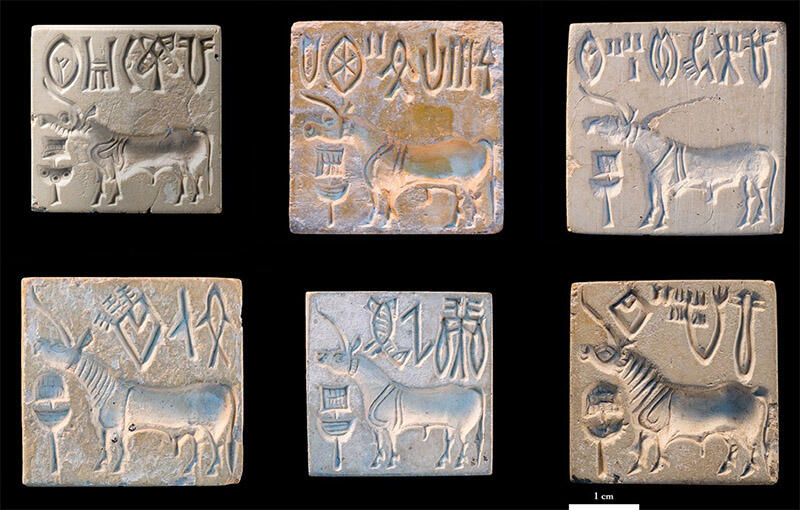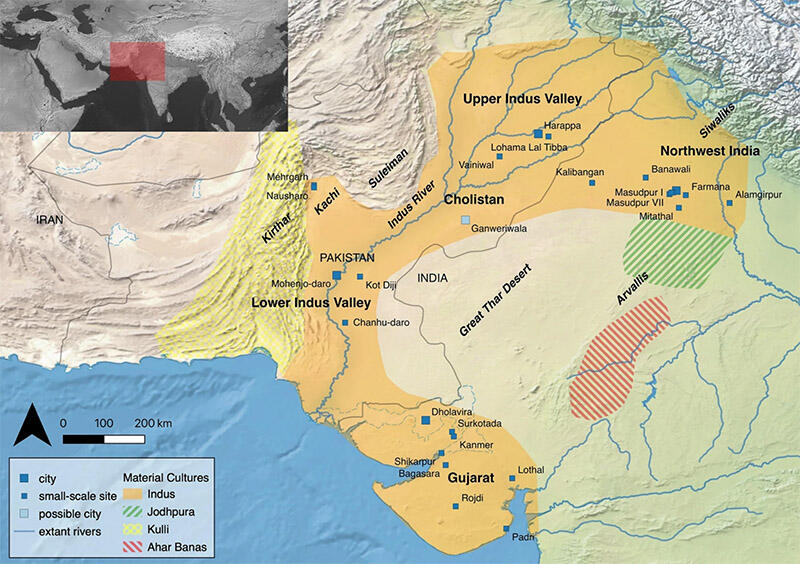A provocative paper which claims that "the Indus civilization reveals that a ruling class is not a prerequisite for social complexity" (p. 1). The author, who is at Cambridge University where he has long been involved with the groundbreaking Two Rains project, starts with John Marshall and other earlier archaeologists noting the lack of monumental architecture, palaces, grand tombs and other markers of hierarchical societies in ancient Egypt and Mesopotamia during the same period as the Indus Civilization. He thinks Marshall basically got it right, and excavations since then have not changed the picture: "I argue that the widespread distribution of production activities and wealth in Indus cities indicates that the stratification of wealth and power, particularly in the hands of a ruling class who monopolized resources and dictated the production activities of everyone else, was absent from the Indus civilization" (p. 2).
Green places his argument firmly in opposition to theoretical constructs like Gordon Childe's (1892-1957). This influential early theorist of the state argued that complex societies and the transition to agriculturally-based civilizations required social stratification. This viewpoint has contributed, in Green's opinion, to many archaeologists postulating the existence of elites in Indus cities despite the lack of traditional signs – say tombs and palaces – for their existence. This has led, he claims, to a certain blindness on the part of archaeologists to the unique, non-elite basis of Indus culture, not to mention errors in paradigms like Childe's which argue that "ruling classes" are necessary for development. He calls these "elite-centered views of social complexity" (p. 4), which have, in an apt use of metaphor, "percolated into the substratum of archaeological thinking about complex societies" (p. 5).
Green brings together a variety of supporting evidence, or rather, points to the lack of evidence of inequality in Indus communities. For example, the rise of stratification is often linked to agriculture, "but there is no strong evidence that Indus food production required a subordinated class of farmers" (p. 13). The houses in Mohenjo-daro, while requiring much more research, show that some were certainly larger than others, but not by much: "The very largest of these were simply houses of above-average size; at best mansions, but not palaces analogous to those occupied by the ruling class in other complex societies (e.g., Trigger 2003, p. 565). Access to a few more rooms does not make you a priest-king" (p. 18). He does not see the drainage systems in the city (human waste collected in large jars, for example, had to be emptied and cleaned) as necessitating stratification - "there are numerous strategies–scheduling, task rotation, and lotteries to name a few–for distributing unpleasant work that do not entail a ruling class" (p. 18). Rather he see in Mohenjo-daro a place where "relative comfort and privacy" seem to "have been widely available" (p. 19).
Instead he points to the sectors in the city, as well as Harappa, as evidence for separate sectors that might have been settled and inhabited by different people or craftsmen; indeed evidence from Anatolia show that people coming together to create marketplaces in contiguous but separated may have led to the development of the earliest cities.
The specialized crafts and high degree of craftsmanship in the production of seals, stoneware bangles or carnelian beads have been held up as evidence of elites who coveted certain goods that distinguished them from others. Green says these were widely available and "not restricted to a ruling class" (p. 21), though it is hard to see how this can be asserted, even if they are found in many contexts. The wide dispersal of craft production within urban centers, even that of complex objects like seals, "does not indicate that their production and distribution was [necessarily] under the control of a ruling class" (p. 24). The enormous collective efforts needed to build Indus cities, like the platforms of Mohenjo-daro which would have each taken thousands of laborers working for a year or more, may imply some sort of centralized control, but this need not have been a ruling class in his reading.
The egalitarian nature of Indus society may also explain its non-domination of other Bronze Age civilizations around the Indus; a limited range of grave goods do not suggest wide differences in social rank. Green writes: "The relative egalitarianism of the Indus civilization has been evident since the earliest excavations at Mohenjo-daro, but there has since been remarkable reluctance to investigate it. This is true both of scholars who assumed the Indus civilization was led by priest-kings and by those who thought that the Indus lacked a state. The inability to account for Indus egalitarianism has resulted in the omission of Indus civilization from comparative discussions of social complexity, which now acknowledge a much broader range of non-hierarchical, non-coercive, and non-elite-centered social formations (e.g., Feinman and Carballo 2018). Indus archaeology has much to contribute to this area of study, and my aim in this article is to encourage a deeper exploration of the implication that complex societies can be egalitarian. However, to grow the critical role for Indus civilization in comparative archaeology, Indus archaeologists need to lose some bad habits" (p. 29). He continues: "Rather than following the general rules proposed for other complex societies, the Indus civilization challenges us to rethink the fundamental connections between collective action and inequality. Sometimes an absence of evidence is indeed evidence of absence, especially when you have spent a century looking for it" (pp. 29-30).
Green addresses the standardized weights and measures, and discusses the possibility of "managerial" and "corporate" groups that could have implemented the high degree of organization we see in Indus material culture like seals and sanitation. Furthermore, "the absence of a ruling class and relative egalitarianism does not necessarily indicate that there were no other forms of inequality in Indus society" (p. 30) which does give Green some wriggle room if we find, one day, that there were groups that somehow organized things and benefited from that in unequal ways, as they have done throughout history in other cultures and civilizations.
Clearly there was something very different, very a-typical about the ancient Indus civilization that we fail to understand, much like the "unicorn," by far the most common creature on seals, that we cannot even name properly name. Green does a superb job of pulling at all these unknown and exceptional elements, and he may be right that we need not presuppose a ruling class to get to a complex society, there may well have been other mechanisms of development involved. But whether they amount to throwing out elites and even rulers is another story. The probability that Indus civilization was so very different from all of its neighbours throughout history, and the cultures that followed it in the same locations, historically, for many thousands of years, all of whom seem to have been pretty much based on hierarchies and ruling elites – the probability that the Indus civilization was so radically different is, in this writer's opinion, small. Not long ago, there was a persistent belief among some archaeologists that the Indus was a "peaceful realm," but this is now discounted. It is likely that hypotheses about there having been no ruling class or classes in Indus times will similarly fade, however provocative it may be today.
A more likely scenario is described by Mark Kenoyer, writing recently (2020) about seals which generally been associated with a ruling class or classes: "The largest variety of seal motifs is found at only the largest sites, such as Mohenjo-daro, Harappa and Dholavira. This suggests that the largest urban centers included a diverse group of people who used seals and script, while smaller sites my have had less diverse groups of elites. Seals with the unicorn motif however are found at almost all Indus settlements. The unicorn seals may have been used by middle to low level merchants or officials who were responsible to reinforce the economic, political and ideological aspects of the Indus ruling elite" (The Indus Script: Origins, Use and Disappearance, pp. 250-51).
See also the article Priest-Kings or Puritans? Childe and Willing Subordination in the Indus by Robin Conigham and Mark Manuel.
Images: 1. A selection of unicorn stamp seals recovered from Mohenjo-daro. Like the majority of Indus seals, they are highly standardized, and all depict the same image. CISI Numbers|Archaeological Survey of India Accession Numbers: Top row (left to right): M-173|63.10/8, M-86|63.10/151, M-116|63.10/29: Bottom row (left to right): M-151|63.10/14, M-97|63.10/15, M-152|63.10/19. Photographs by the author.
2. Map of the Indus civilization and some contemporary neighboring material cultures. Five main regions are highlighted, as are the size and location of sites discussed in the text. Data are projected in WSG 1984 on version 4.0 of the Natural Earth Basemap using QGIS 3.10.




